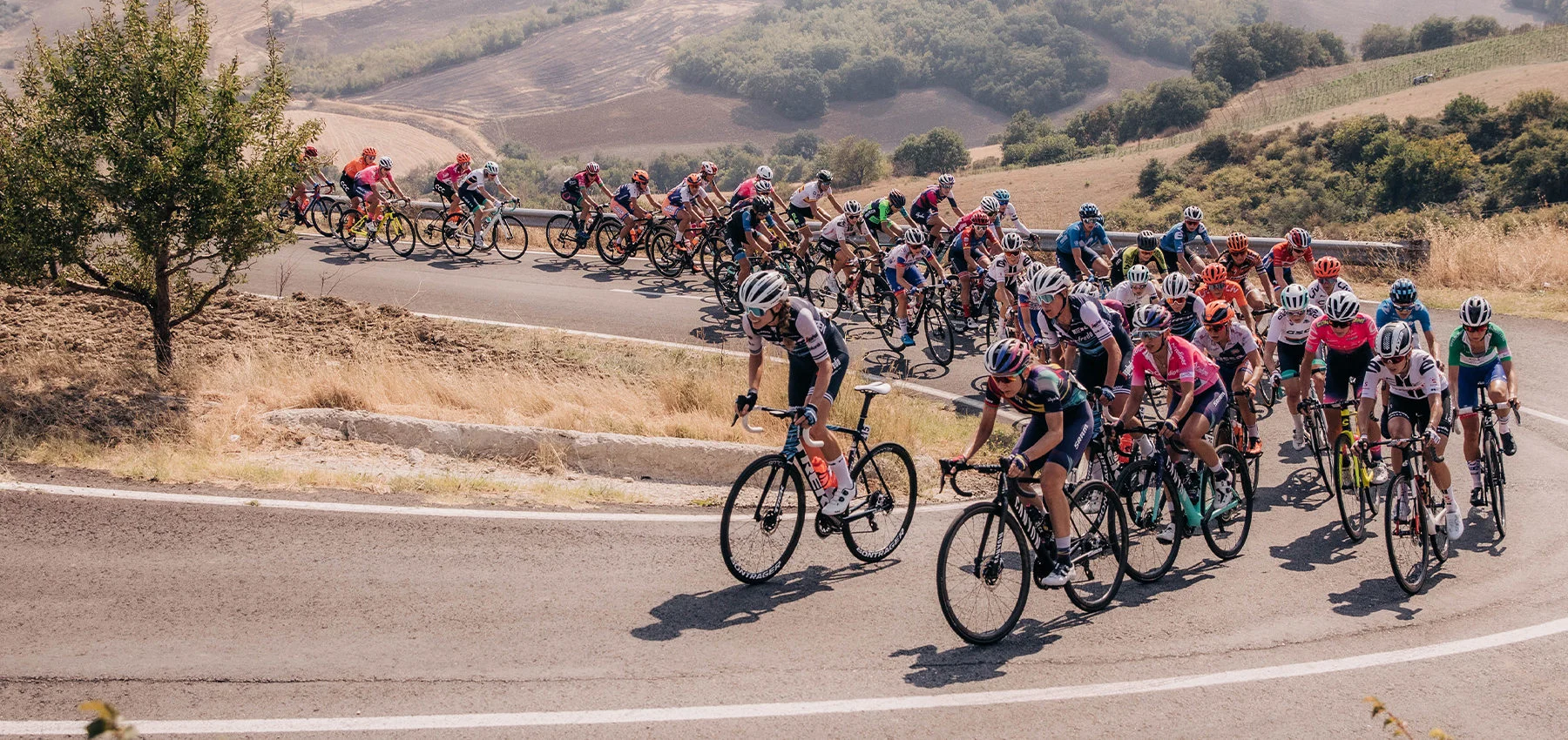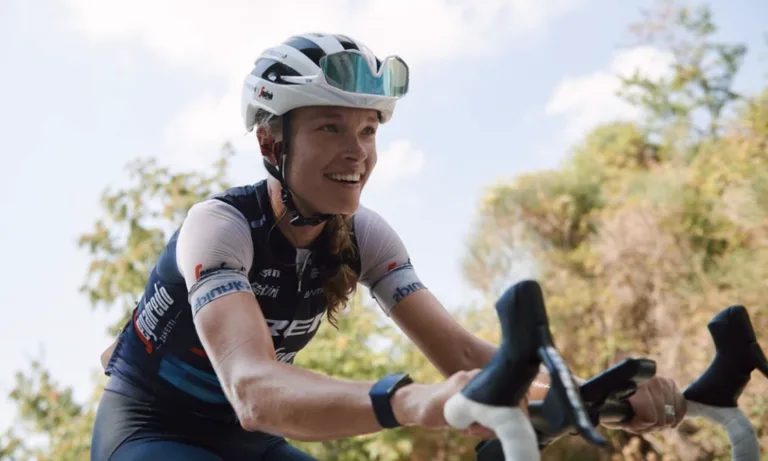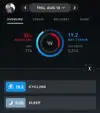Topics
- Article
- Cycling
- Women’s Performance
Tayler Wiles on Cycling, Cycles and Fatigue

As athletes, we are incredibly in tune with our bodies. This is a trait that can both improve performance and also drive us absolutely crazy.
Throughout my career, I’ve become more diligent about tracking the good and bad days and the feelings and sensations that go along with them. At times I’ve found myself overthinking every ache, every muscle that’s slightly tight, and every grumble of my stomach. Over the past few years I’ve discovered that monitoring what my body is telling me in a meaningful way has taught me so much about what gives me power, as well as what weaknesses I can work to correct. Unlocking a lot of this began when I started using WHOOP in 2018. I was fascinated by the insights it revealed and what I could learn about my body from the data it provided on sleep, heart rate variability, resting heart rate, and more. I also love that it has a feature that allows you to track not only your daily habits, but the timing of your menstrual cycle as well.
Understanding My Cycle and the Impact of Nutrition
My cycle has always been an area of immense frustration for me. Its timing has a big impact on my performance and I have frequently had trouble navigating it. As a female athlete in a sport where power-to-weight ratios are unfortunately a focus, I’ve experienced moments throughout my career when my cycle has disappeared completely--an all too often occurrence among female endurance athletes and one of the symptoms of RED-S (Relative Energy Deficiency in Sport). With a disappearing cycle (or an incredibly inconstant one) it became nearly impossible to track and make the changes I needed to be my best physiologically during its various phases. I have been incredibly lucky to work directly with Dr. Stacy Sims, one of my all-time personal heroes, and a groundbreaking researcher who has literally written the book on how to navigate your cycle as a female athlete (it’s called ROAR). Dr. Sims shared valuable knowledge as to what I was missing nutritionally, and after a period of time giving my body what it needed I was able to regain a consistent cycle. This consistency enabled me to have control again and I no longer felt powerless to my cycle.

Battling Fatigue
Unfortunately, I learned this year that nutrition is not the only factor that affects my cycle, fatigue does as well. Earlier this season I found myself yet again with a disappearing cycle. This time my nutrition and weight were good, but my feelings during training and racing were not. After a hard block of training at altitude I began racing the following weeks, and I knew something was not right. I had an incredible feeling of fatigue in my legs during hard efforts--a burning sensation that was difficult to recover from after repeated efforts. This was not the normal sensation of lactic acid build up that as athletes we are all too familiar with. It was as if my legs were on fire and completely empty. I had felt strong at altitude and my numbers in training were really solid, but suddenly I had an incredible sense of fatigue. At first I thought it was just the need to recover from my time spent at altitude. I’d take a few days to rest, try to push again in training or a race, and boom--the feeling was still there. I started to be very vigilant about what I was eating to make sure I was getting what I needed. I also began paying extra attention to my WHOOP sleep stats, which were consistently pretty good.

However, there was one thing I could not ignore, the day-after-day red recovery scores from my WHOOP. These red recoveries were not just after hard workouts, races, or bad nights of sleep. They were popping up even after multiple days of recovery and nights of really solid sleep (like a 23% recovery on 7:49 sleep, followed by only a 32% recovery after 8:28 sleep). I just couldn’t shake them, nor could I shake the fatigue I was feeling day after day in training and racing.
Losing my Cycle Again and Taking Time Off
Then it happened. My cycle became a week late, then two, then three. A trend from my past that I was not happy about repeating. So, I decided to wake up and really listen to the red recoveries. I spoke with my coach and he agreed that I would take 5 full days off the bike. Due to the COVID-19 pandemic racing was all but canceled, and then suddenly brought back and condensed into an incredibly intense 3-month calendar. Having all of these big races (and big opportunities) all smashed together and coming at me like a freight train made the thought of taking time off feel devastating. But, also not as devastating as the idea of continuing to be “running on empty” during every training session and race going forward. With our only Grand Tour the Giro Rosa just around the corner, I was committed to doing whatever it took to find my legs again. So I put my faith in my WHOOP, touched base with Dr. Simms about my nutrition, and gave my body 5 days. I was diligent about my sleep, treatments, nutrition and also my mental state.
Competition and Recovery Returning to Green
As an elite athlete self criticism can be hard to shut off, especially when you are in a phase of recovery. We always want to do more, be the best, and push the limits. Sometimes our bodies just finally say no. After a few days the red scores turned to yellow, then a few more days and those yellows turned green. On Day 5, my cycle started. It was the first time I’ve ever done a happy dance for the first day of my cycle, but I was just so thrilled to have a sign that my body was finally getting to a better place. I did some short, sharp rides leading into the Giro to wake up my legs, and was incredibly relieved that the burning fatigue I’d felt for weeks prior was gone. In fact, on the morning the race began, I had a 98% recovery!

The Giro started with a bang and my team, Trek-Segafredo, had an incredible victory together in the Stage 1 Team Time Trial! Overall we had a very successful race, with my teammate Elisa Longo Borgini ending on the overall GC podium.
Why WHOOP?
As female athletes we have to commit to tuning into our bodies and making sure we are doing everything possible to maintain a healthy cycle, in both our sporting careers and our daily lives. I find WHOOP to be an incredible tool to track my physiology. I’ve been able to trust the data and use it in such impactful ways. Train hard, but be smart. Feel your sensations and make note of them. If you follow the trends without overthinking them, the direction they can give you is incredibly powerful. Photo Credits: David Powel and JoJo Harper